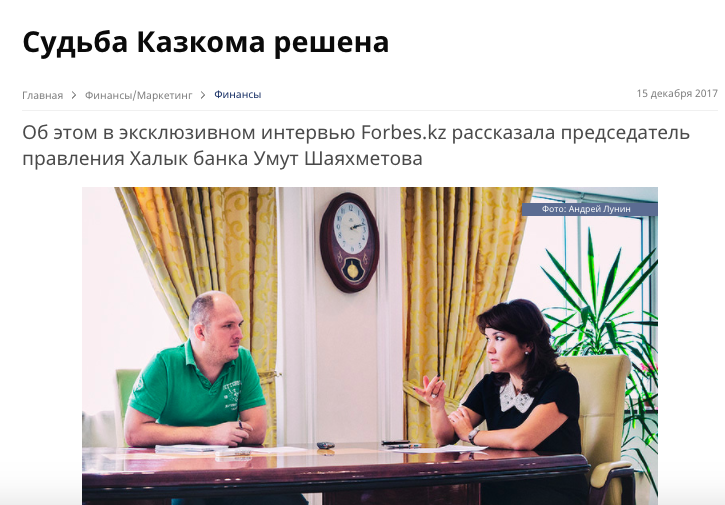In the middle of December 2017, an event of the historic significance took place in Kazakhstan. On that day, the Halyk Bank press service announced the integration of Kazkommertsbank with the “parent” structure and the end of its existence as a legal body.
The press-release titled “The Halyk Bank Board of Directors Approves the Step-by-Step Integration with Kazkommertsbank” is short, so we will quote it in its entirety (text in bold ours – Kazakhstan 2.0).
“The Halyk Bank of Kazakhstan and Kazkommertsbank (later referred to as Halyk Bank and Qazkom, respectively) announce that the Halyk Bank Board of Directors has approved the integration of the two banks via the merger of Qazkom and Halyk Bank.
The merger will take place after the completion of all the required procedures including the necessary approval from the regulatory agencies.
“After the five months of the meticulous work with the international consultants, we can say with certainty that the deal has a huge potential both in its scale and the degree of its influence on the economy of Kazakhstan as well as a number of the neighboring states.
The integration of the banks seems to be the most optimal way for the group’s further development, – says Halyk Bank Chairperson Umut Shayakhmetova. – The principle of the maximum synergy based on the strongest sides of both banks lies at the core of the integration process. We will take the best the banks can offer – the country’s most developed bank infrastructure and the risk management of Halyk Bank, the modern technologies and the client service standards of Qazkom as well as the knowledge, know-hows, experience in serving millions of clients and the most competitive products and services of both banks”.
The merger of Qazkom and Halyk Bank will be completed upon creating the necessary conditions and finishing all the service and technological preparations. This includes the synchronization of the product supply, the banking procedures and processes, the integration of the IT-systems and the bank infrastructure.
“We believe that the merger and the creation of the largest bank will ease the access to loans and a wider product line for the clients and will give the additional stimuli for the business and economy development. The investment possibilities of the Halyk Group will enable to actively develop Qazkom’s advanced technologies and know-hows. All this gives us certainty that, in the future, we will preserve and strengthen our technological leadership and the quality of the client service”, – says Kazkommertsbank Chairperson Ulf Vokurka.
The main emphasis in the integration process will be made on ensuring the uninterrupted functioning of all the Halyk Bank and Qazkom services so the clients do not experience any inconvenience.
We started improving the services and easing the access to them with the ATM networks merger in July 2017. Later, Halyk Bank and Kazkommertsbank have completed the joined projects related to the card business including the Halyk Light + Homebank Orange loan program. Already in the nearest future, the banks will present a number of services related to money transferring and online paying, launch a completely new online-bank and its mobile application for entrepreneurs. The banks will try their best to fully unlock the merger’s synergy potential for the clients”.
The next day, Umut Shayakhmetova commented on the press-release in her exclusive interview to the Forbes-Kazakhstan magazine.

She said that there had been several scenarios of the merger including the possibility that one bank would specialize on the corporate banking and the other – on the retail banking. Finally, they decided to integrate the banks. However, Shayakhmetova’s confession that some sort of the “personnel optimization” is going to take place in the future is the key point of the interview. Here is a quote: “We are not expecting any harsh scenarios. I think the personnel issue will be completely resolved upon the completion of the merger. Obviously, some kind of optimization will take place. The final organizational structure of the bank, however, has not yet been defined”.
With that, the merger of the two banks will be happening not only on the level of the head offices but on the level of the affiliated organizations as well. Here is how Halyk Bank Chairperson answered the Forbes’ question on what was to happen with the banks’ subcompanies.
“The decisions have already been made on some of them. We have two banks in Russia that will merge as well but on the base of Moskommertsbank – the process has already started. We have decided to merge Kazkommerts-Polis and Kazakhinstrakh. The other foreign banks will, understandably, stay in the group. We have not yet decided on Halyk Finance and Kazkommerts Securities. We are following the development of the pension market, perhaps, one of the companies will specialize in managing retirement assets”.
Now let us explain why we call the Halyk Bank Board’s decision to integrate the affiliated Kazkommertsbank a historic one.
First, the last private bank of the four systemic financial institutes that, prior to 2009, had been violently competing with each other will disappear. Note that, in 2009, under the pretext of their rescue, Akorda forcibly nationalized BTA Bank and Alliance Bank after which the banks had found themselves in the critical condition. They had been restructured numerous times but did not survive, nonetheless.
As for Halyk Bank, we believe it cannot really be called private since it belongs to the members of Nursultan Nazarbayev’s family and has always received the state support (last time, via the “rescue operation”). Therefore, it will be more correctly to put it into the quasi-state business structure category.
Second, it has been confirmed that having the close (including the family) ties with the political authorities of the country is the major competitive advantage in Kazakhstan. Out of the four groups of the entrepreneurs who controlled Halyk Bank, Kazkommertsbank, Alliance Bank and BTA Bank, only Dinara and Timur Kulibayevs (President Nursultan Nazarbayev’s second daughter and son-in-law) have been able to keep their banking business.

As for Mukhtar Ablyazov, Margulan Seysembay, and Nurzhan Subkhanberdin and their partners, the first two lost their banks as early as 2009. With that, Ablyazov, Akorda’s open political opponent from 2002, is still being persecuted by the Kazakhstan authorities whereas Margulan Seysembayev has had the opportunity to return to the country and enter the business market.
Nurzhan Subkhnberdin whose ties with Akorda are closer than those of Ablyazov and Seysembay but not as tight as Dinara and Timur Kulibayevs’ had stayed in business until 2014-2015.

Third, the merger of Halyk Bank and Kazkommertsbank completes the process of the nationalization of the Kazakhstan banking system when the quasi-state financial institutes controlled by Nursultan Nazarbayev’s close relatives like Dinara and Timur Kulibayevs and Akhmetzhan Esimov or his trusted people such as Adilbek Dzhaksybekov and Bulat Utemuratov (never mind, directly or through relatives) become dominant in the financial sector of the country.
As for the Halyk Bank Board’s decision on the merger, we believe it was inevitable. Today, we have a clear oversupply of the financial institutes in need of the effective demand from the physical and legal bodies. The demand that will allow them to not just function but generate normal of high profits for their shareholders. And, since Akorda is incapable of increasing the real incomes of the Kazakhstanis and launching the non-resource sectors of the economy, the participants of the financial market must adapt to the existing realia.
This is why Halyk Bank has decided to widen its business-niche via closing its affiliated structure. Moreover, this decision will help it to “optimize” the personnel number and the branch network while greatly simplifying the group’s management.
It is obvious, however, that purging the market of the “weak” financial institutes will not end there. We believe, one way of another, about one half of the existing banks will leave the market either through merging with stronger organizations or via bankruptcy. The strongest always survives in Kazakhstan be it the politics, the economy, the intra-clan issues, or the officials’ infightings.




